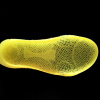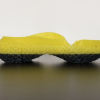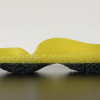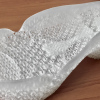3D cushioning zonal sole
Technology description
| The name of the technology: | 3D cushioning zonal sole |
|---|---|
| Challenge: | There is minimal technological updating in footwear manufacturing companies, while the actual impact on research and development is lacking, and the footwear itself is mainly addressed in design. However, there is a lack of use of biomechanical knowledge in the production of footwear functionality. This state is given by the current trend when the manufactured model must meet the requirements for design, trend, not health properties. Therefore, this project represents active zonality, i.e., the decomposition of the sole of the foot in relation to footwear. It is a specification of the part of the foot to which the precisely defined function of the internal 3D heterogeneous structure of the sole applies. Such an application can be called a system enabling immediate personalized 3D production of footwear with specific requirements. This system, built on the intersection of materials, technologies and biomechanical design, allows the immediate 3D production of personalized footwear using |
| Description: |
The human body reacts to an external stimulus by an adaptable manufacturing process. This process is known as Wolff's and Davi's law (The Oxford Dictionary of Sports Science & Medicine). This phenomenon predefines the exact bone and muscle mass structure needed for the strength constructional features of the human body together with bone and muscle mass suitable material composition. Under a certain load, this feature automatically builds up bones', ligaments' or muscles' mass structure. It defines the shape—such a process we use as a society separately by analyzing, modelling and fabrication process. The zonality is understood as a decomposition of the foot and its sole in relation to the footwear. It is a specification of the part of the foot to which a precisely defined function is applicable to the outsole of the footwear. The map of individual parts of the sole is created through the detailed decomposition of the sole into zones. These zones have their character and function. The map then provides a complete image of how to create footwear that can meet the extreme demands of its owner. The use of these defined elements brings a precisely defined function applicable to the footwear outsole. This can create healthy, zonal, functional footwear. • Heel part of the foot – damping • Part of the inner longitudinal arch of the foot – support • Insole part of the foot – balance • Toe joint circumference = TJC – comfort • Tread part or Outsole part of the footwear – antislip resistance |
| Commercial opportunity: |
This system can be applied to any footwear. By using 3D technology, it is possible to create footwear not only faster, in the order of hours, but more accurately. Using a 3D scanner and applying generative design makes it possible to respond to the owner's needs for such footwear in real-time. A comprehensive system connects material properties and construction characteristics with the production 3D process. List of companies: Bennon Group a.s. Vasky Vuch Baťa Maison Margiela Prada Balenciaga Issey Miyake Raf Simons Dior Adidas Nike Puma Under Armour New Balance Zellerfeld |
| IP protection status: | Czech utility model No. 36862 and Community industrial design No. 015009622-0001 |
| Development status: |
Phase 2Corresponds with TRL 3 and TRL 4 Feasibility study. There is a realistic design of the technology and the initial tests in the laboratory are leading to the specification of the technology requirements and its capabilities.
|
| Partnering strategy: | Collaboration licensing |
| More information: | |
| Images: | |
| Categories: | Chemical and bioengineering Engineering |
| Institution: | Tomas Bata University in Zlín |
| Owner of a technology: | Univerzita Tomáše Bati ve Zlíně |




